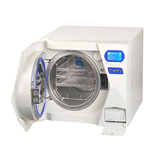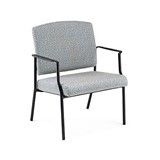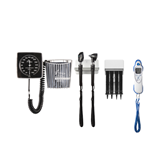Vital signs monitor buying guide for Australian clinics. Explore costs, options, maintenance, and compliance essentials.
Key Takeaways
- Pricing: Ranges from $1,200 for basic units to $8,000+ for advanced models with wireless and modular features.
- Monitor types: Commonly 3-parameter (SpO2, NIBP, Pulse) or 5-parameter (adds ECG, Temp) units.
- Typical spend: Most clinics invest between $3,000 and $5,500 for reliable, multi-use monitors.
- Compliance: Must meet TGA regulations and IEC 60601 safety standards.
- Maintenance: Annual costs range from $150 to $500, plus occasional parts like sensors and batteries.
- Financing: Leases or loans from $50 per week help manage upfront costs.
- Warranties: Standard cover is 1–3 years, with extended options available.
Introduction
If you're managing a medical clinic, aged care facility, hospital, or mobile health unit in Australia, having a reliable vital signs monitor (VSM) is essential for real-time patient assessment. These devices measure critical indicators like blood pressure, pulse rate, oxygen saturation, and body temperature.
With a wide range of brands and models available locally, this guide will help you compare prices, understand operational features, and assess which type of monitor best fits your setting, budget, and compliance requirements.
Types of Vital Signs Monitors
Vital signs monitors differ based on the number of parameters they measure, their portability, connectivity, and target use cases.
1. Basic Monitors (3-Parameter)
- Measures oxygen saturation (SpO2), non-invasive blood pressure (NIBP), and pulse rate.
- Suitable for GP clinics, aged care centres, and outpatient facilities.
- Price range: $1,200 to $2,800.
2. Advanced Monitors (5-6 Parameter)
- Includes ECG, temperature, and sometimes respiratory rate in addition to standard parameters.
- Suitable for hospitals, surgical units, and high-acuity care.
- Price range: $3,500 to $6,500.
3. Modular Monitors
- Customisable systems with plug-in modules for anaesthesia, capnography, or other specialised monitoring.
- Commonly used in ICU, operating theatres, and recovery units.
- Price range: $7,000 to $12,000 or more.
4. Wireless and Mobile Monitors
- Designed for remote monitoring and EMR integration via Bluetooth or Wi-Fi.
- Ideal for multi-bed facilities, in-home care, or large practices.
- Price range: $4,000 to $8,500.
How Vital Signs Monitors Work
Each monitor collects data from external sensors and displays readings in real-time. Here is a brief overview of how each parameter is captured:
- SpO2 (Oxygen Saturation): Uses a finger sensor with light absorption to measure oxygen levels.
- NIBP (Blood Pressure): An automated cuff inflates to detect systolic and diastolic pressure.
- Pulse Rate: Often detected via either ECG electrodes or the SpO2 sensor.
- Temperature: Measured with digital thermistor probes (oral, rectal, or axillary).
- ECG (Electrocardiogram): Captures heart activity using lead cables attached to the chest.
Maintenance and Operating Costs
Ongoing costs are relatively low but necessary to ensure accuracy and extend the lifespan of the device.
Routine Maintenance Includes:
- Regular cleaning of sensors and display screens.
- Annual calibration checks (recommended cost: $200 to $300).
- Firmware updates and software maintenance if applicable.
Common Parts That Require Replacement:
- SpO2 sensors: $80 to $150.
- BP cuffs: $60 to $120, depending on size and material.
- ECG cables: $120 to $300.
- Rechargeable batteries: $150 to $400 every 2 to 4 years.
Warranties and Support
Standard Warranties
- Most monitors come with a 1 to 3-year manufacturer’s warranty, covering defects and electronic failures.
Extended Warranties
- Can be purchased separately, often priced between $400 and $800, depending on the duration and coverage.
Support Services
- Look for local suppliers offering technical support, backup loan units, and on-site servicing to reduce downtime.
Financing Options for Australian Buyers
Spreading out your investment through equipment finance can help improve cash flow and accelerate acquisition.
Lease or Rent-to-Own Plans
- Payment terms from 12 to 60 months, starting at around $50 per week.
- Often includes service or maintenance support.
- Allows you to upgrade equipment more frequently.
Business Equipment Loans
- Offered by banks and finance companies with rates from 7 to 12 percent per annum.
- May be eligible under the Instant Asset Write-Off scheme.
- Suits businesses looking for long-term ownership.
Talk to a medical finance broker or supplier who can arrange tailored packages specific to healthcare.
Compliance and Certification in Australia
Before you commit to any purchase, it’s essential to ensure your vital signs monitor complies with Australian regulations.
TGA Registration
- All medical devices used in patient care must be listed on the Australian Register of Therapeutic Goods (ARTG).
- You can check this via the TGA website or ask your supplier to confirm registration.
Electrical and Safety Standards
- Devices must meet IEC 60601-1 standards, which cover electrical safety for medical-grade equipment.
- This ensures the equipment is safe for use in both low-risk and high-acuity clinical environments.
Cybersecurity Requirements
- For wireless-enabled monitors that integrate with EMRs, ensure the device complies with Australian Cyber Security Centre (ACSC) recommendations to prevent unauthorised access or data breaches.
Frequently Asked Questions (FAQs)
What type of vital signs monitor is best for a general practice?
A basic 3-parameter model is typically sufficient, priced from $1,200 to $2,800. Look for options with optional temperature or ECG upgrades.
Can I use a single monitor across different departments or rooms?
Yes, many models are portable and include internal batteries. However, it’s essential to use fresh cuffs and clean sensors between patients to prevent cross-contamination.
Do I need internet access for these devices to function?
No. Most units function fully offline. However, if you want automatic record syncing with your EMR, you will need internet-enabled models.
Is it safe to buy refurbished monitors?
Yes, if purchased from certified medical equipment providers. Ensure the unit includes TGA compliance documentation and a warranty. Refurbished models typically cost 30 to 50 percent less than new ones.
What is the typical lifespan of a monitor?
With proper care, monitors can last 5 to 10 years. Battery replacement and sensor wear are the most common maintenance concerns.
Final Thoughts
Investing in the right vital signs monitor isn’t just about choosing the cheapest option – it's about ensuring accuracy, compliance, support, and long-term value. By understanding your clinical needs, patient volume, and available budget, you’ll be in a strong position to make a smart and sustainable purchasing decision.
















